Mayflower anniversary: The replica ship that never set sail
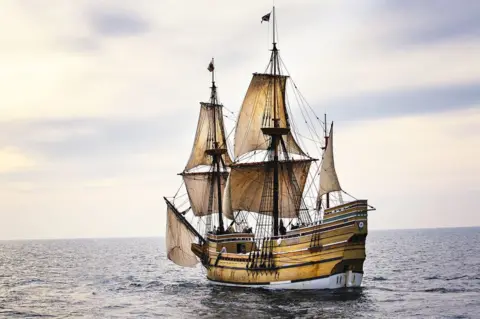 BBC
BBCIt was a lofty ambition: To build a life-size replica of the 17th Century Mayflower and recreate the Transatlantic crossing that set sail 400 years ago. But despite hundreds of thousands of pounds spent, no ship was ever built. What went wrong?
In 2009 a meeting took place to consider how the small Essex town of Harwich might commemorate the 400th anniversary of the Mayflower setting sail with a group of Puritan settlers seeking a new life in the New World.
The Mayflower set off on 16 September 1620 from Plymouth - but is widely thought to have been built more than two decades earlier in Harwich, the home of the ship's master and joint owner, Captain Christopher Jones.
Eventually they landed in what they called New Plymouth, in what is now Massachusetts.
Initial suggestions as to how Harwich might celebrate its role in the Mayflower anniversary were fairly low key. Putting up bunting was one suggestion.
It was a dentist - Tom Daly - who first had the idea of building a sea-going replica of the original Mayflower in the town.
"Harwich sometimes has a small view of the world," he said. "I'd watched over the first 15 years I was in Harwich as the place declined.
"I thought, 'look, we need something bigger, that would deliver amazing tourism infrastructure and offer training'."
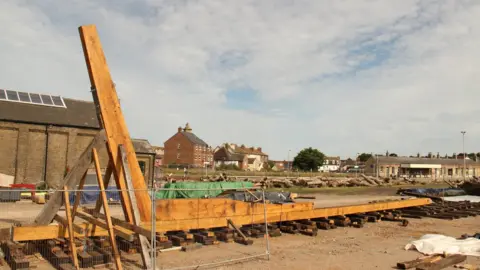 Harwich Mayflower Project
Harwich Mayflower ProjectA charitable venture, the Harwich Mayflower Project was set up shortly after with five directors setting itself a multimillion pound fundraising target to get the ship built.
The idea was to sail the ship across to the US and then back to Harwich, where it would become a major tourist attraction.
The estimated costs rose steadily between 2009 and 2018, from a £2.4m initial estimate, to £4m in 2013, to about £6m in 2016 and then up to £10m, according to a statement from those involved in July 2017.
"As well as plans for the ship we were trying to provide employment opportunity for youngsters through training," said Mr Daly. "At the beginning there was a sense of excitement and we were all very enthused by it all."
The first task was not building a ship at all, but building a shipyard in which the ship could be built. As well as this, a working project office had to be established, the necessary experts - from ship's architects to ship-building carpenters-cum-tutors - had to be assembled and procedures for taking on apprentices put in place.
The keel log was only prepared for cutting towards the end of 2013.
The project generated wide-scale interest, including from the likes of explorer Sir Ranulph Fiennes and entrepreneur Sir Richard Branson, as well as US citizens who at one stage were reportedly arriving in Harwich in their thousands to witness the building work first hand.
But by the end of 2016, the only parts of the ship that had gone up were the keel, the bow and a pair of side ribs.
Officially, serious doubts about the likelihood of a sea-going vessel being built only emerged in 2016, despite a reported claim by the then vice-chairman of the project Lynda Chase-Gardener, who told a meeting of Harwich Town Council: "It's a two-year build and professionally qualified engineers have confirmed it is a two-year build (followed by a period of allowing timbers to expand in water and sea trials) - so we are on track to sail in 2020."
Miss Chase-Gardener, who resigned from the board of trustees in March 2017, did not respond to a BBC request for comment about Harwich's Mayflower scheme.
 BBC
BBCBut former apprentice Rebecca Hawkins claims some inside the project were voicing doubts as early as 2013.
Ms Hawkins joined the project as a Level 3 Business and Administration apprentice in January 2013 aged 18, earning a little over £400 a month.
"There were arguments going on back in 2013 with people saying we've got to get started or there won't be a ship in time," she said. "There was a bit of a worry even back then that it was not going to get built.
"Others were saying, 'no, no, don't worry, it'll get built'."
She told how the Mayflower Project was "a lovely group of people to work with", adding: "I felt quite proud to say that I'd worked there."
But she described a number of issues, including apprentices being sent off to other ship yards to work, no tutor being assigned to her own apprenticeship course and difficulties training up enough apprenticeships to meet the requirements of building an ocean-going ship.
Ideas for fundraising for the project were various - from sponsored ship bolts (which did happen) to taking deposits for cabins once the ship was ready (which did not).
But the 100ft (30.5m) long ship never was ready.
"We got the bow up and one rib, I believe. There's no ship there. All that work and hard effort that was put in and there's little to show for it," said Ms Hawkins.
"It is a shame that nothing has happened.
"It went from it was going to be a sea-faring vessel to a display vessel. Perhaps they should have just built a miniature."
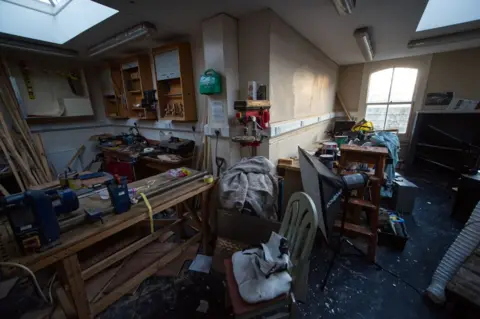 BBC
BBCRumours swirl around Harwich about where all the money for the project went, either the private donations or official grants. And the whereabouts of the multiple lorry loads of oak sent to Harwich from Truro in Cornwall. And the many expensive power tools gifted to the project.
Ms Hawkins for one said she had heard the conspiracy theory about the "missing" oak.
The truth of the matter seems a little more mundane.
"People gave money and that was used for business essentials such as electricity and materials," said Mr Daly, who was chairman of the project until 2016.
As for the oak, which was paid for by Mr Daly out of his own pocket, "it is still there", he said.
The exact location, because of the value of the timber, was not disclosed - though a number of people told the BBC it had been recently sighted in an area of private land in the town.
"The other items of materiel are in storage," he said. "Nothing was taken out of the project that wasn't earned.
"It was a business like anything else - lighting, insurance, rent to British Rail and so on. And in terms of donations, every pound of that was put back into the project."
In fact, if anybody has lost out on the project it is Mr Daly himself. Although he is reluctant to give an exact figure, it is understood he invested more than £250,000 of his own money into the Mayflower dream.
"I had to stop because my wife would have killed me," he said.
So what went wrong?
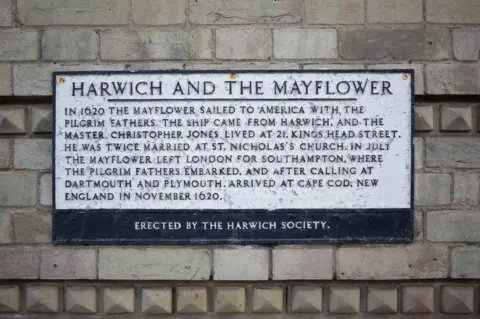 BBC
BBC"We did get quite a lot of small donations," said Mr Daly. "But we were cost heavy. We had to pay teachers, ship-wrights, lighting, electricity - everything that a business has to pay. We needed substantial funding.
"Early on, we had a ship's architect to design a ship that would comply with Maritime and Coastguard Agency regulations and from that we were able to work out how much it would cost.
"That [the £4m cost] would have been achievable. Yes, the cost did go up - but if that money had come in, the ship would been built."
According to the charity's statement of accounts, the effort did not come to close to achieving even the lowest and earliest estimate.
Between 2009 and 2018 (the last year for which accounts are available), the charity had £1.73m in income and in four of those years spent more than it received.
"We applied for government funding and [submitted] three applications for National Lottery funding," Mr Daily said.
"It was very time consuming. Applications take up hundreds of hours and then you're told 'no'."
The exact reasons the project failed to get large-scale funding awards remain unclear. Mr Daly said the project was repeatedly pipped to the post by other charities.
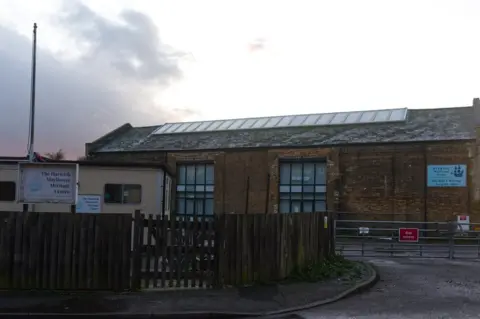 BBC
BBCMr Daly feared the worst in 2016-17.
"At that stage, if it was going to be ocean going we needed it being well under way in 2017-2018 and ready for sea testing," he said. "The funding wasn't forthcoming."
He believes the project would have "changed the whole tourism outlook for Harwich" adding: "We tried hard on this and we had an awful lot of good people who put massive amounts of time and energy into this because they could see what it could achieve.
"We didn't achieve an ocean-going ship, but there were many other positive things that came out of it."
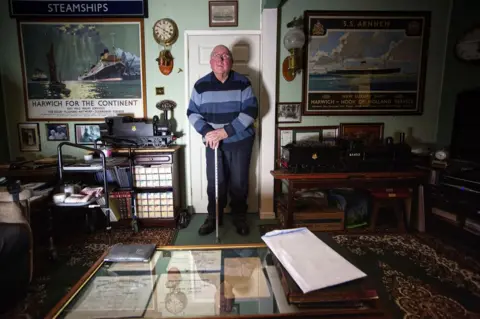 BBC
BBCIn 2016, the training centre closed due to a lack of funding. In all, about 600 apprentices had passed through its doors during over the six-year running period.
The project's buildings - which were based within a former railway station - were instead given a new lease of life as a heritage museum.
By July 2017, according to the annual trustees' report, the idea of building a sea-going vessel had been formally shelved and a rail and shipping centre idea brought centre stage. And instead of a sea-faring vessel, a land-based replica was now the aim.
For rail expert Bob Clow, the chance to restore the railway station to its 1920s heyday was too good to pass up.
"I had looked at Harwich station 20 years ago with the objective of doing exactly what we're doing now," he said.
"When we started, I knew there was a lot of problems with the Mayflower Project," he said.
But because he was only involved in the heritage centre side of it, Mr Clow pressed ahead and has seen his designs for the recreated 1924 station come to fruition.
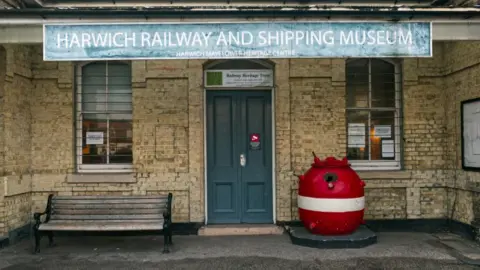 BBC
BBCThe Harwich Railway and Shipping Museum has since become a separate entity with its own board of trustees and financial independence.
"It is the light at the end of a very long tunnel."
The Harwich Mayflower Project changed its name to Harwich Mayflower Heritage Projects Ltd in May 2018 and then to Harwich Cultural and Community Projects in March 2020.
The BBC contacted the successor organisation for comment about the Mayflower story but did not receive a response.
The project still has use of a three-acre site where the ship was meant to be built (it was offered for temporary lease by Network Rail).
Tony Francis, who said "it would have been nice to have a British-owned replica of the Mayflower", has for months been trying to generate interest and support to put that land to community use.
"This community fundamentally needs that land for community use and to become something very special," he said. "I'd like to see a heritage village down there with pre-fab homes because decent housing is the number one need."
As for the Mayflower ship, not only did the sea-going replica never materialise - the planned life-sized shore based replica didn't either.
But there is a sculpture. On a roundabout.
And Ms Hawkins suggests that if the town pulls together it should perhaps give the idea of building a sea-going replica another chance - for the 500th anniversary.
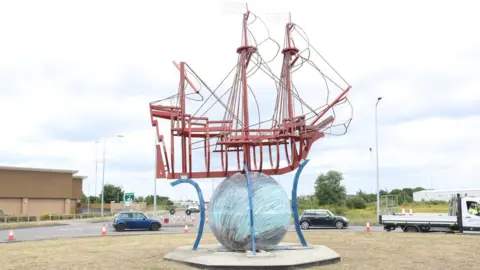 BBC
BBCFind BBC News: East of England on Facebook, Instagram and Twitter. If you have a story suggestion email [email protected]
Photography by Laurence Cawley unless otherwise stated.
